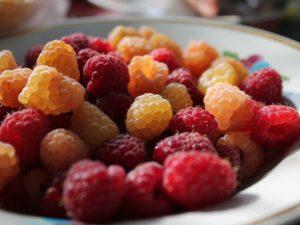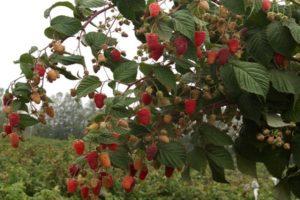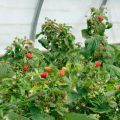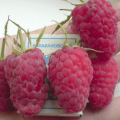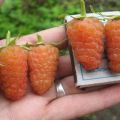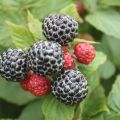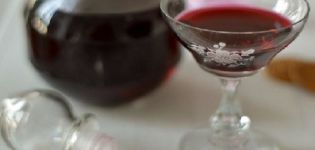How can you treat raspberries from pests during flowering and fruiting?
Almost every gardener plants a garden plot with healthy and fragrant raspberries. There are times when raspberry bushes begin to bear fruit poorly due to the attack of insects or diseases. In order for the planted plants to get sick less often, you need to figure out in advance how to process raspberries from pests during fruiting and flowering.
When you need to process raspberries for disease prevention
Before protecting shrubs from worms in berries and diseases, you need to determine when it is best to process. Experienced gardeners recommend processing the remontant bush in the spring, in the first half of April, when the first snow melts and the first buds begin to appear on the seedlings. In March, spraying is not done, since the daily temperature can drop below five degrees Celsius.
You can also process plants in the fall, after the leaves fall. In early November, branches that have ceased to bear fruit are cut from the bushes, and the most weakened shoots are removed. Only after preliminary pruning is preventive treatment carried out.
The best remedies for treatment and treatment
To find the most effective tool for working with raspberries, you need to figure out what is the best way to spray it.
Shop products
Quite often, store-bought chemicals are used to protect raspberry seedlings from ailments and insects. Effective drugs that can treat raspberry bushes include:
- Mikosan. It is used to enhance the immunity of seedlings. The composition of the product contains components that help to quickly get rid of pathogens of fungal diseases.
- "Healthy Garden". The drug is used to protect berries from aphids, sawfly and other dangerous pests. It is sodium-based and sold as soluble granules.
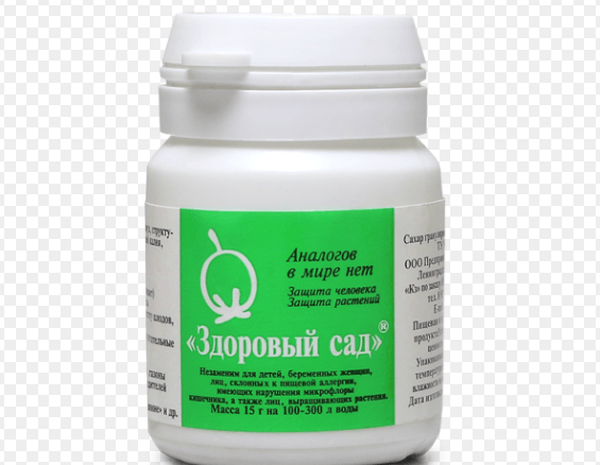
Folk remedies
There are gardeners who prefer to save berries not by store means, but by folk remedies.
Copper sulfate
Spring and summer are a good time to treat raspberries with a solution made from copper sulfate.Before spraying, you need to figure out how to make a vitriol solution yourself. For therapeutic and prophylactic purposes, use a slightly concentrated mixture. To prepare it, 150 grams of the substance is added to 8-9 liters of warm water. Then everything is stirred for 5-10 minutes and infused for half an hour.
It is necessary to spray the seedlings with vitriol in protective gloves and glasses, so that droplets of the product do not fall on the body. You also need to make sure that there are no small children and animals nearby.
Iron vitriol
During flowering and when fruiting begins, you can use iron sulfate. It is used for the following purposes:
- saturation of the soil with iron;
- treatment of wounds that may be on the surface of the branches;
- strengthening old raspberry bushes;
- prevention of the development of fungal pathologies;
- insect protection.
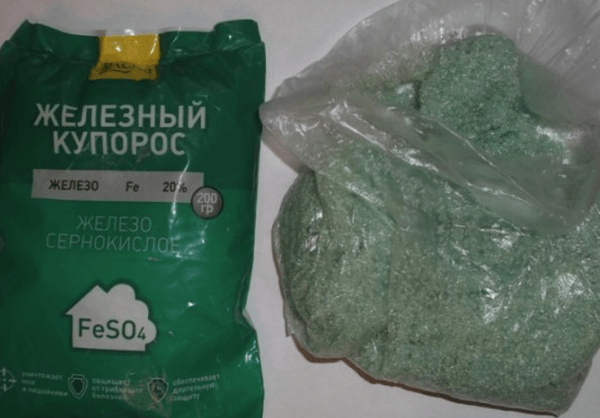
When creating a working solution, half a kilogram of the substance is added to a ten-liter container with water. The prepared product is used no more than twice a season. Raspberries are processed in the evening or morning, when there is no sun.
Boiling water
Another common prevention method is the use of hot water. Boiling water is used in the following cases:
- elimination of kidney mites and protection of seedlings from this dangerous parasite;
- cleaning seedlings from spores, due to which powdery mildew may appear;
- an increase in the number of peduncles, which increases the yield;
- elimination of aphids, which often attack raspberry bushes.
Before sprinkling a raspberry bush, you need to protect its root system from boiling water. For this, the surface of the soil is covered with polyethylene, which will prevent hot water from entering the soil.
Urea
Some gardeners prefer to protect shrubs with urea. When working with urea, the following recommendations are followed:
- Preliminary preparation. Before processing, the soil is loosened near each bush and weeds are removed.
- The choice of the day for work. A garden bush of raspberries is treated with urea on sunny and calm days.
- Compliance with safety rules. It is necessary to work with the solution in rubber gloves, goggles and a mask.
- Preparation of the mixture. 750 grams of urea and 50 grams of copper sulfate are added to a bucket of water.
Raspberry shoots are watered with urea 3-4 times per season.
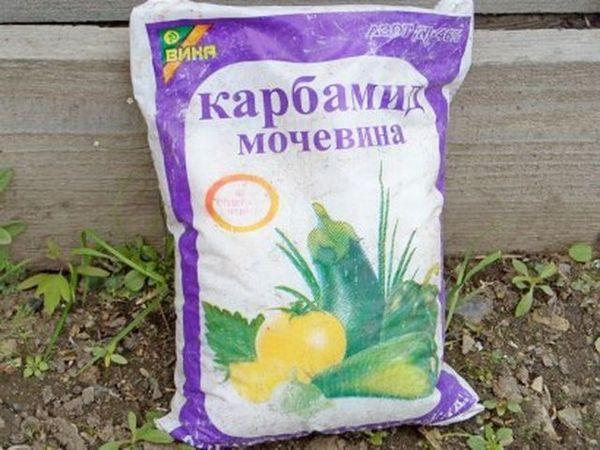
Bordeaux liquid
Most often, this tool is used when biological products are not able to protect the shrub. Autumn is considered the best time to apply Bordeaux liquid. During this period, the growing season of the bushes is completely completed, and therefore the agent will not be able to harm the plants.
To prepare the product with your own hands, add half a kilogram of lime to three liters of water. After that, another two liters of warm water are poured into the container. Then, 40 grams of copper sulfate is added to 10 liters of boiling water, after which the mixtures from two containers are stirred and infused for 20-30 hours.
Mustard and soda
To cure raspberry diseases, you can use a mixture made from baking soda and mustard. It is a versatile mixture that can kill chlorosis and protect seedlings from rot and anthracnose. Some people use it to increase the amount of sugar in the berries and improve their taste.
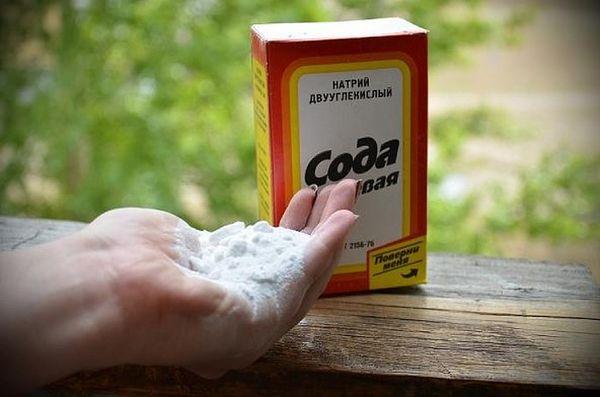
When creating an effective remedy for raspberry diseases, add 80 grams of soda and 20 grams of mustard powder to 5-6 liters of heated water. You can use the liquid after flowering is complete.
Ammonia
Some believe that ammonia is used only in medicine, but this is not the case. It is used in the gardening industry as a fertilizer and helps fight common diseases. Also, using solutions of ammonia, you can protect seedlings from such insects:
- ants;
- flower midges;
- bear;
- aphid.
A large amount of alcohol can harm the plant and therefore the dosage must be observed when creating a solution. Add 50-60 milliliters of alcohol with grated laundry soap to a bucket of cold water. To prevent a pest from appearing on the bushes, spraying is done 1-2 times a month.
Degtem
To scare away insects, tar is often used, which has a pungent odor. Shrubs are processed twice - before and after flowering. When creating a product in 10-15 liters of water, add 2-3 spoons of tar.
Diseases of raspberries and how to deal with them: terms and technology for processing bushes
If you take care of the shrubs poorly, they begin to hurt and die. It is recommended to familiarize yourself with the characteristics of common raspberry diseases and methods of their treatment.
How to treat raspberries from late blight (root rot)
The main reason for the appearance of root rot in shrubs is a high level of soil moisture. The main symptoms of late blight include black bloom on the pistils, mold and yellowing of the foliage. Also, in diseased bushes, flowers are deformed and dry up.
To combat the disease, a garlic solution with manganese is used. It is prepared from 8-10 liters of warm water, two grated heads of garlic and 5 grams of manganese. For each diseased shrub, half a liter of liquid is consumed.
Root cancer
The disease appears due to the ingress of bacteria into the root system of a raspberry seedling. The disease is accompanied by growths on the root collars and the lower part of the stem. The leaf plate is covered with yellow spots, which darken over time. Root cancer develops very quickly and therefore, when these symptoms appear, treatment should be started.
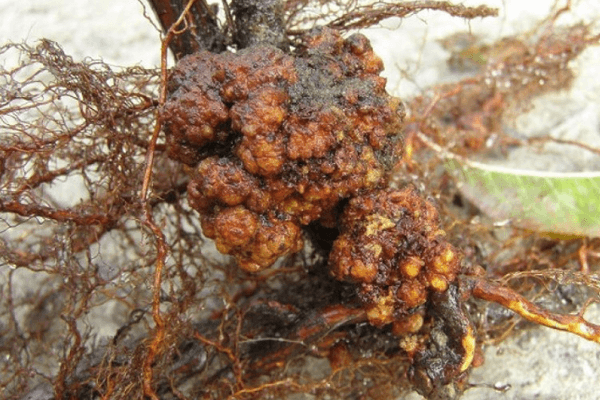
To combat the disease, a 1% solution of copper sulfate is used, which destroys the causative agents of root cancer.
Root rot (late blight)
Phytophthora is a dangerous disease caused by a fungus that develops in conditions of high humidity. Each leaf of a diseased seedling begins to blush and dry out at the edges. If you do not treat phytophthora, the shoots dry out completely. There are several remedies for root rot:
- A piece of chalk. 10 grams of chalk is mixed with 400 milliliters of water and 5 grams of copper sulfate. The solution is used to treat the affected stems and leaves.
- Iodine. The substance is diluted with water in a ratio of one to five. The shrubs are sprayed with an iodine mixture 2-3 times a week.
Gray rot
Gray rot on raspberries leads to a deterioration in fruiting and death of berries. The fruit of the infected bushes is covered with a brown bloom. Most often, gray rot appears on shrubs that are grown in waterlogged greenhouses. Also, the disease develops if the plant is grown near infected seedlings.

To save plants, experienced gardeners recommend getting rid of all infected berries and cutting off the stems that are starting to wilt.
Verticillary wilting
July is the month when raspberry bushes begin to suffer from verticillary wilting. The danger of the disease lies in the fact that it slows down fruiting and stops the development of the bush. First, a yellow bloom appears on the leaves and stems, after which the shoots begin to wither.
It is impossible to cure the disease, and therefore everything must be done so that raspberries do not get sick with verticillary wilting. For this, the bushes are regularly sprayed with fungicidal preparations and urea.
Chlorosis
The development of chlorosis on raspberry shrubs is evidenced by yellow spot on the leaf blade. This viral ailment is very dangerous, as it is not easy to get rid of it. Chlorosis slows down the ripening of the crop and the berries dry out.
To protect berries from disease, the bushes are treated with a sulfate solution. Raspberries are processed in mid-March, when the first buds appear on the seedlings.You can also use a methyl emulsion sprayed on the raspberry tree two weeks before flowering.

Rust
Rust begins to develop in the last decade of May, when flowering ends. It is quite simple to identify the disease in time, since it has pronounced symptoms. The leaves of bushes infected with rust become covered with an orange bloom, which will eventually become convex. A darker bloom appears on the back of the leaf plate.
The remedies that treat rust include:
- Sagebrush. Fresh grass is poured with cold water and infused for 3-4 days. Then the liquid is filtered and used to process raspberries.
- Soda. Five spoons of the substance are mixed in 7-8 liters of water, after which raspberry leaves are sprayed.
Infectious chlorosis
If raspberry leaves have yellow spots, chances are high that they are sick with infectious chlorosis. At first, yellowing appears near the veins, but gradually the surface of the leaves covers one large yellow spot.

To eliminate chlorosis, peat, compost and humus are added to the soil. Also, raspberries are fed with potassium compounds that will help get rid of the symptoms of the disease.
Mosaic
Mosaic appears on bushes after aphid attack, which is considered the main carrier of viral pathogens. A characteristic feature of the disease is green and yellow spots on the leaves. If the mosaic is left untreated for a long time, convex growths will appear on the surface of the leaf plates. Infected shrubs should be watered with Kemifos and Fufanon.
Curliness
With the development of curliness, the trunk of the shrubs darkens, and the raspberry shoots are shortened and bent at the edge. If the disease appears in the fall, all the leaves acquire a bronze tint and begin to die off. If the curl is not treated, the bushes will stop growing. In the treatment of the disease, fungicides and copper sulfate are used.
Anthracnose
Anthracnose is a dangerous disease in which a red bloom with a brownish tint appears on the surface of the foliage. The disease appears due to a lack of organic fertilizing and the use of infected tools.
To quickly get rid of fungal pathology, diseased stems of shrubs are cut off and potash and phosphorus fertilizers are added to the soil.
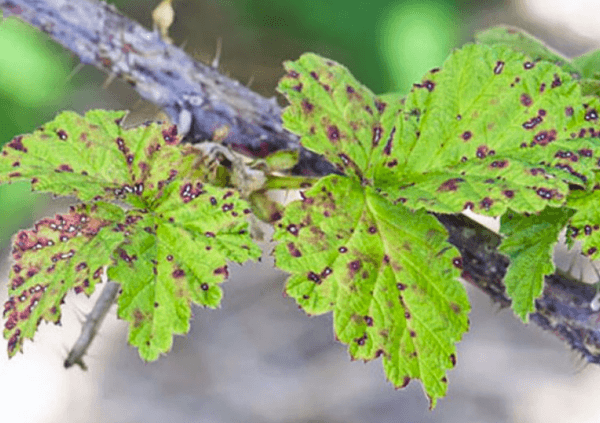
Septoria (white spot)
Due to septoria, specks appear on the surface of raspberry leaves, which are painted white with a brown border. Gradually, spotting passes from the leaves to the main stem and shoots.
Infected bushes need proper care, without which they will die. Diseased leaves are carefully removed from the bushes, after which the raspberries are sprayed with fungicides.
Didimellosis (didimella)
Didymella is a common disease that affects not only raspberries, but other berries as well. At the initial stage of the development of the disease, the leaves with stems are covered with purple spots. Over time, the mottling darkens, hardens and cracks. When didimella appears on the bushes, the following control measures are used:
- biological products;
- bordeaux liquid;
- iron or copper sulfate.
How to treat raspberries from pests
To protect raspberry bushes from insects, you need to decide how to spray them during cultivation.
Raspberry beetle
The main reason for the appearance of wormy raspberries is the raspberry beetle, which attacks bushes. The insect is activated in the second half of spring, when early berries begin to form. The pest feeds on leaves and fruits.
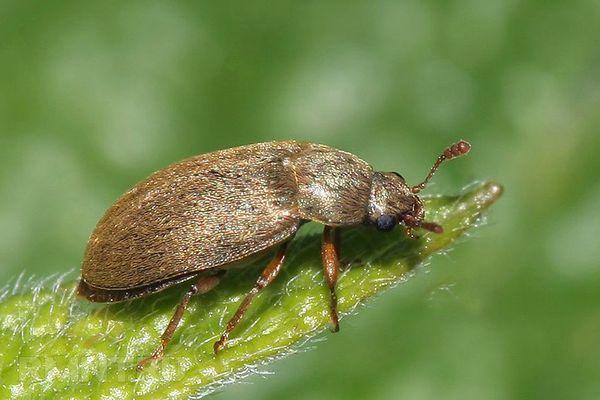
Since the bug infects fruits, it must not be sprayed with chemicals. The only thing you can do with it is to collect it by hand.
Stem gall midge
Rot on young berries may appear due to the attack of stem gall midges. Adults lay eggs on the leaves, from which caterpillars then appear. Young gall midge bites into raspberry stalks and eats them from the inside.
The stems, into which pests have penetrated, will have to be completely cut and burned.
Stem fly
The most dangerous pest for raspberry bushes is considered to be the larvae of stem flies. They, like gall midges, penetrate the shoots and feed on plant sap. Because of this, the leaves and stems of raspberries turn red, and a gray bloom appears on the berries.
To prevent the fly larvae from spreading throughout the plant, the affected shoots are cut out, after which wood ash with vitriol is added to the soil.
Raspberry mite
It is difficult to notice this insect in time, since its length rarely reaches one millimeter. You can find raspberry mites only when they have covered the entire bush. Hand picking insects will not help get rid of ticks, and therefore you will have to use preparations for spraying raspberry seedlings. Effective means include "Nystatin" and "Trichopol".
Spider mite
If there is cobweb on the stems of raspberries, then a spider mite attacked the raspberry bush. Also, the appearance of a tick is indicated by an oily coating located on the back of the leaves. Most often, the tick-borne bug appears in May, so the preventive treatment of berries is carried out in April. They are sprayed with urea, vitriol and fungicides.
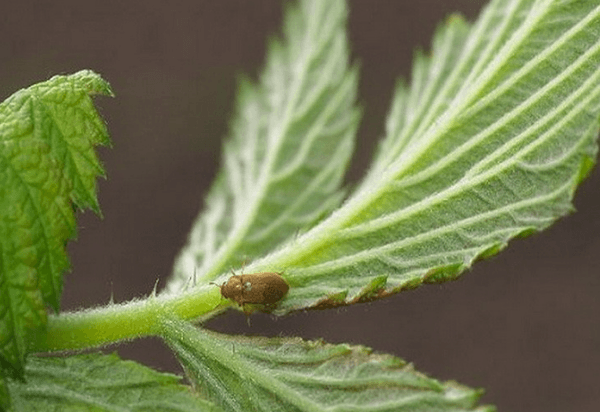
Raspberry-strawberry weevil or flower beetle
It is a small caterpillar that feeds on young foliage and lays eggs on it. The insect is activated during the flowering period and penetrates the flower buds to eat them from the inside. The main preventive measure for the appearance of weevils is regular inspection of the leaves and the removal of the deposited larvae.
Kidney moth
If a brown butterfly flies near the bushes, it means that a kidney moth attacked the plant. Adults do not harm raspberry seedlings, since the main harm is caused by their larvae. They penetrate young stems and buds of seedlings to suck the juice out of them. This leads to a slowdown in the further development of shoots.
Leaf roll
Leafworms lay larvae on the inside of raspberry leaves. Young individuals feed on the sap of the leaves and penetrate the fruits, which makes the crop rotten and wormy. The leafworm attacks plants from late May to the first half of September.
To eliminate pests, an effective folk method is used - wormwood broth with the addition of tomato tops and tobacco.
Raspberry moth
Raspberry moth enters the shoots of shrubs, which stops their growth and develops overgrowth. Also, moth larvae can penetrate ripe berries and spoil them. All drying stems that are affected by insects are cut and burned.

Cicadca
It is a small pest that attacks raspberries and vegetables. You can find leafhoppers on raspberry bushes by light spotting on the surface of the leaves. Many people believe that such insects cannot harm raspberries, but this is not the case. If you do not get rid of them in time, the bush will dry out. Fungicidal agents, as well as an infusion of garlic and wormwood, will help get rid of leafhoppers.
Raspberry glass
This is a yellowish butterfly laying larvae on the foliage of raspberry seedlings, which suck the juice from the bushes. Most often, the glass vessel lays eggs at the bottom of the stems so that the larvae can penetrate to the roots. Shoots infected with glass ceases to bear fruit and develop. A white powdery coating appears on them, which decays over time.
Conclusion
People who grow raspberry bushes often encounter pests and diseases that impair yields. To protect plants, it is recommended that you familiarize yourself with the main products that are used to process raspberries.
